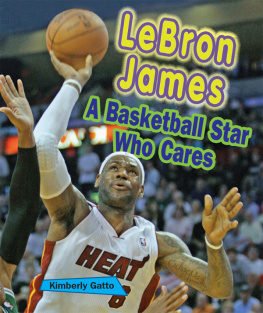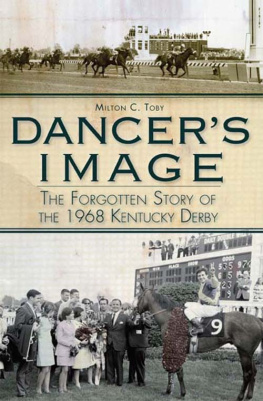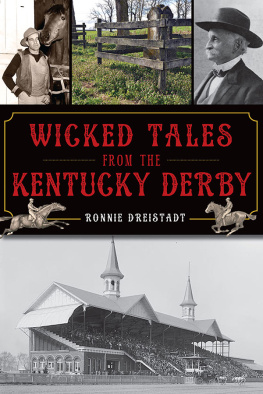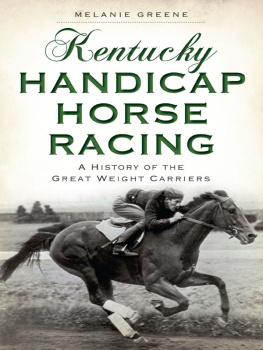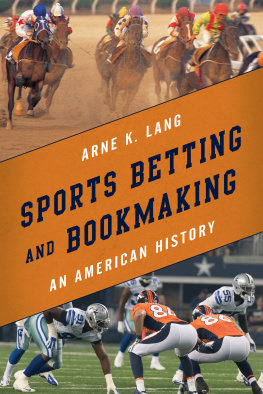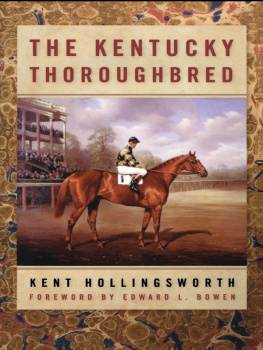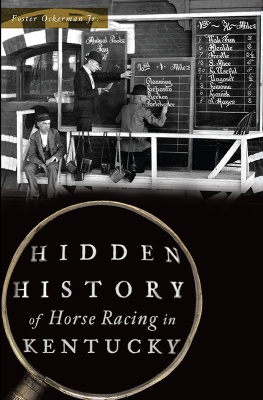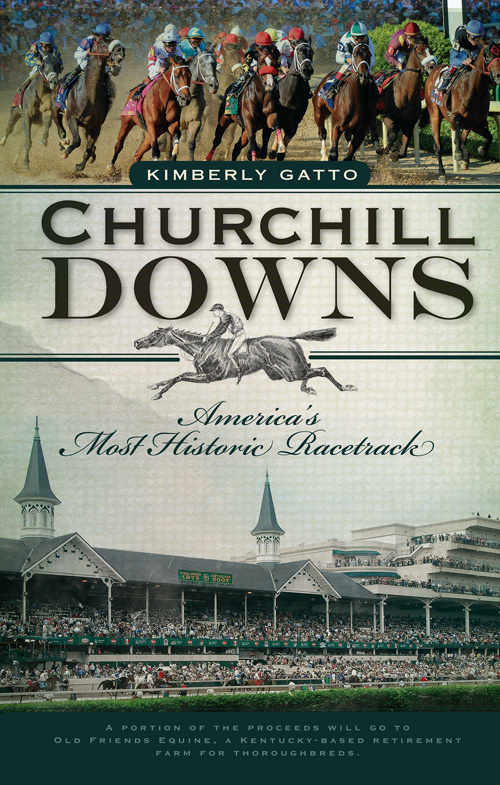

KIMBERLY GATTO

Published by The History Press
Charleston, SC 29403
www.historypress.net
Copyright 2010 by Kimberly Gatto
All rights reserved
Front cover: Ryan Armbrust/Sniper Photography. Drawing courtesy of Keeneland Library.
First published 2010
e-book edition 2011
ISBN 978.1.61423.164.6
Library of Congress Cataloging-in-Publication Data
Gatto, Kimberly.
Churchill Downs: Americas most historic racetrack/Kimberly A. Gatto.
p. cm.
Includes bibliographical references.
print edition ISBN 978-1-59629-887-3
1. Churchill Downs Racetrack (Louisville, Ky.)--History. 2. Horse racing--Kentucky--Louisville--History. 3. Churchill Downs Incorporated--History. I. Title.
SF324.35.K4G38 2010
798.4006876944--dc22
2010002065
Notice: The information in this book is true and complete to the best of our knowledge. It is offered without guarantee on the part of the author or The History Press. The author and The History Press disclaim all liability in connection with the use of this book.
All rights reserved. No part of this book may be reproduced or transmitted in any form whatsoever without prior written permission from the publisher except in the case of brief quotations embodied in critical articles and reviews.
In loving memory of
Chutney
(Mid ArcAppleaday)
19772008
One of the great ones
CONTENTS
FOREWORD
Sometimes the place is the thing. Yankee Stadium. Fenway Park. Madison Square Garden. The Forum in Montreal. Lambeau Field. Churchill Downs.
Many fans only see the Twin Spires on the first Saturday in May when its worth your life to find a parking place and a spot where you can stand and breathe at the same time. They recall Sunday Silence racing in the optimism of Arthur Hancocks Stone Farm going head to head, nose to nose with the cherry and black Phipps colors, representing Arthurs brother, Seth. Under a cunning ride by Pat Valenzuela and a superb training job by Hall of Famer Charlie Whittingham, the strapping black stallion prevailed. Or maybe its when Winning Colors, the champion filly, defeated the boys in 1988 or, of course, Secretariat.
There are many fine books chronicling the Kentucky Derby, but you need to nearly go back to Down the Stretch: The Story of Col. Matt Winn, as told to Frank G. Menke, to uncover an account of Americas most famous racetrack thats as enlightening and entertaining as Kim Gattos.
Lavishly illustrated and doggedly researched, this history of Churchill Downs breathes new life into an old story. You can almost hear the creaking of the old grandstand as it trembles under the impact of extravagant suites along Millionaires Row. Gattos prose takes us beyond the grandstand and the Derby into the heart and soul of an institution built on the heart of Man o War and the soul of his son, War Admiral.
Churchill Downs is to horse racing what Fenway Park is to baseball and Madison Square Garden is to basketball. It is the stage where every race is its own independent drama, not only for the rich and famous but also for the old trainer and owner who never got the big horse.
Just to be able to play on the stage where Gallant Fox and Whirlaway prevailed is enough. Kim Gatto takes us on the memorable stroll from the backside to the paddock with grace and confidence and into the winners circle. Enjoy the journey.
Michael Blowen
Founder and President
Old Friends Equine
Georgetown, Kentucky
ACKNOWLEDGEMENTS
The author would like to thank the following individuals for helping to make this work possible: Ryan Armbrust/Sniper Photography, Allison Pareis, Jamie Newell, Jessie Holmes, Chad B. Harmon, Jim Evangelou/Gallery of Champions and Eric Larson/Cardcow for allowing the use of their photographs;
Ann Tatum of Kinetic Corp., Phyllis Rogers and Cathy Schenck of the Keeneland Library, Amy Purcell of the University of Louisville, Diane Bundy of the Kentucky Historical Society, Jason Flahardy of the University of Kentucky and Mark Taflinger of the Courier-Journal for assistance with photographs;
Sharon Inglis and Patrick Lennon for their careful reviews of the manuscript;
My wonderful editors at The History Press for their assistance along the way;
My second familySharon, Scott, David and Nicole Inglisfor their continued support and friendship, and Sharon and Nicole for accompanying me on my first trip to Kentucky; and
All of my family members and friends, and particularly my mom, Ann Urquhart, for always believing in me.
Prologue
HORSE RACING IN LOUISVILLE
Thoroughbred racing in Louisville, Kentucky, has a rich and storied history. According to local sources, races were held on Market Street in downtown Louisville beginning around 1783. In nearby Lexington, informal races took place in a park-like area called the Commons. Citizens soon began to voice concern with regard to the safety of racing on city streets, which led to the construction of two courses. The first was developed in Lexington in 1789. The other, established in 1805, was based at Shippingport Island, a peninsula near the falls of the Ohio River; it was known as Elm Tree Garden. A third track, the Hope Distillery Course, was created on what are now Sixteenth and Main Streets in Louisville around 1827. There were also a number of smaller private tracks, including Beargrass, which was owned by Captain Peter Funk of the Kentucky Mounted Militia. The majority of races at that time were long-distance contests run in a series of four-mile heats.
The men who organized the first race meet formed the commonwealths original Jockey Club; it was formally named the Kentucky Jockey Club in 1809. Among its founders was Kentucky statesman Henry Clay. The popularity of thoroughbred racing in the area eventually led to the development of the Kentucky Association in 1826. This group of horsemen was responsible for the creation of various rules and regulations, including the arrangement of standard racing distances, the handicapping of horses based on the amount of weight carried and the adoption of a British rule whereby a horses racing age is determined based on his/her age as of May 1 of the current year; this date would later be changed to January 1. The latter served to ensure that horses were not given an unfair advantage by racing against younger, less mature animals in the same age class.
Oakland Race Course was the first Louisville track to gain national recognition. Named for the oak trees that lined its borders, the facility included a three-story Greek Revival mansion with a clubhouse, a hotel and a ladies pavilion. Oakland was established in 1832 by the Louisville Association for the Improvement of the Breed of Horses, a seventy-six-man organization that included distinguished locals such as Robert Breckinridge, C.W. Thruston and James Guthrie. The course was built on a fifty-five-acre parcel purchased from brothers Henry and Samuel Churchill, with the latter serving as the racetracks first president.
By the late 1830s, Oakland had become the areas premier thoroughbred track. On Monday, September 30, 1839, it hosted one of the most famous races in Louisville history. It was a face-off between Kentuckys own Grey Eagle and Wagner, the pride of the South. Two other horses also entered the race, which offered a lucrative purse of $14,000 and was composed of three four-mile heats. Grey Eagle, a four-year-old, was the local hero, whom


